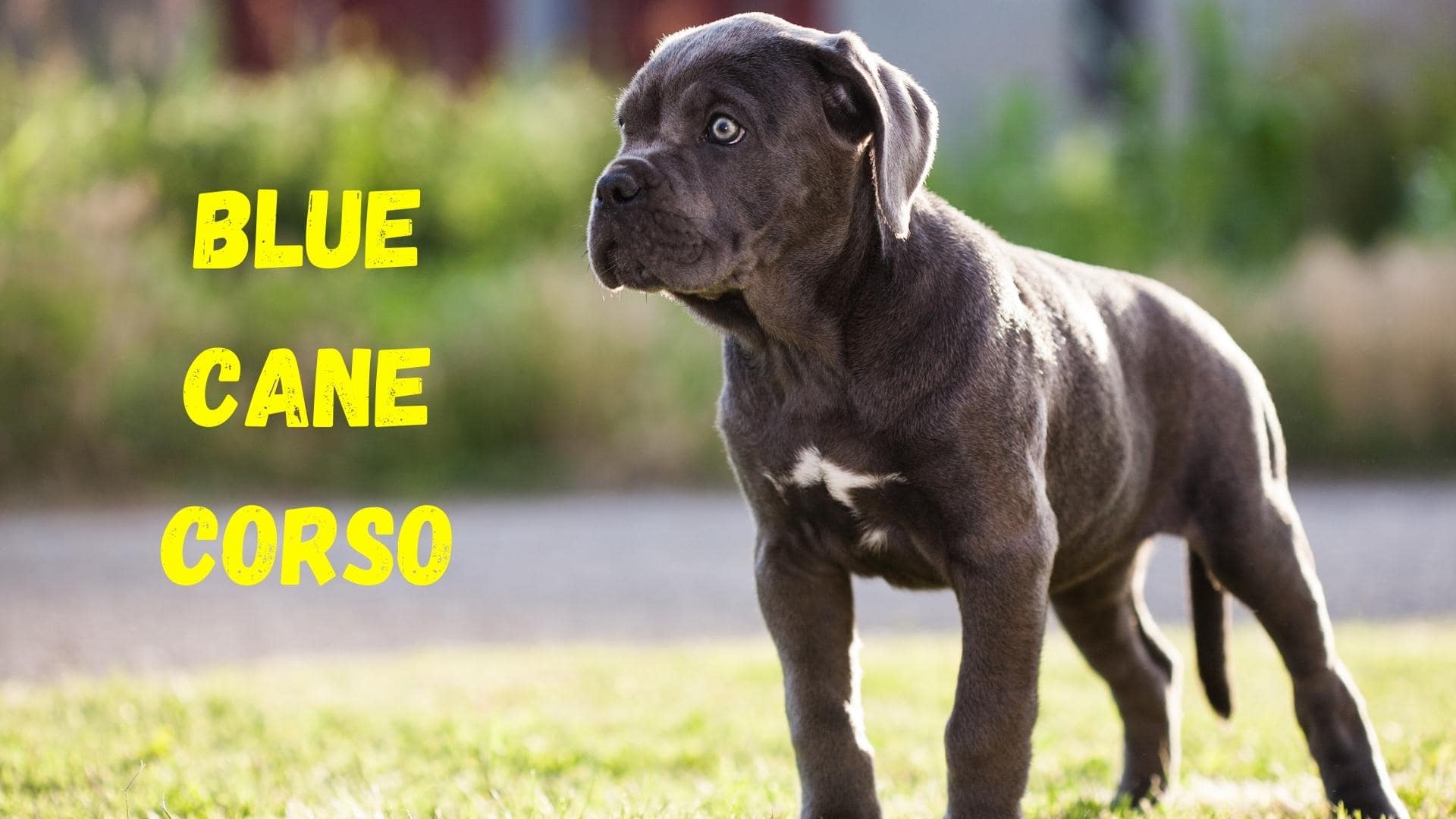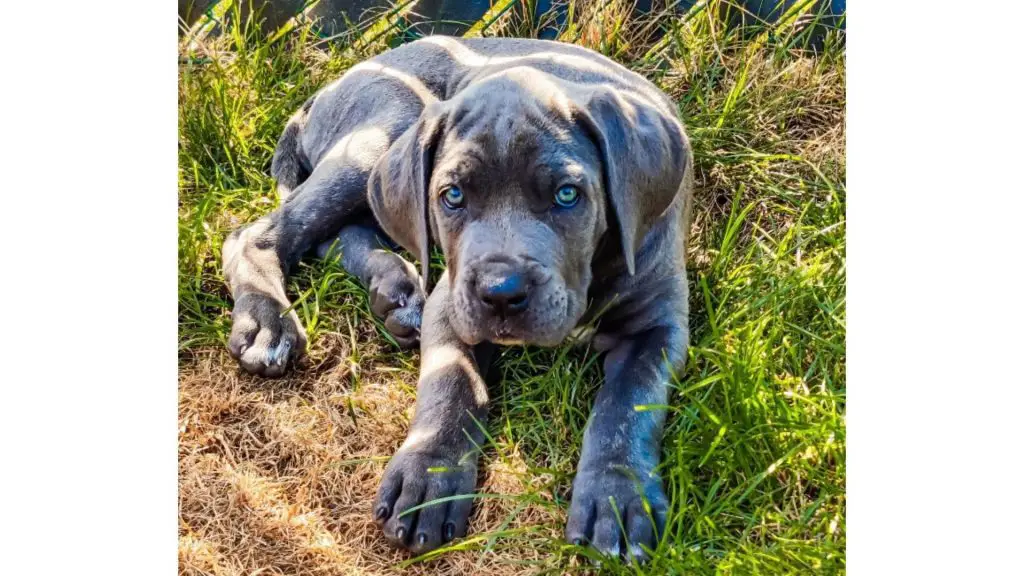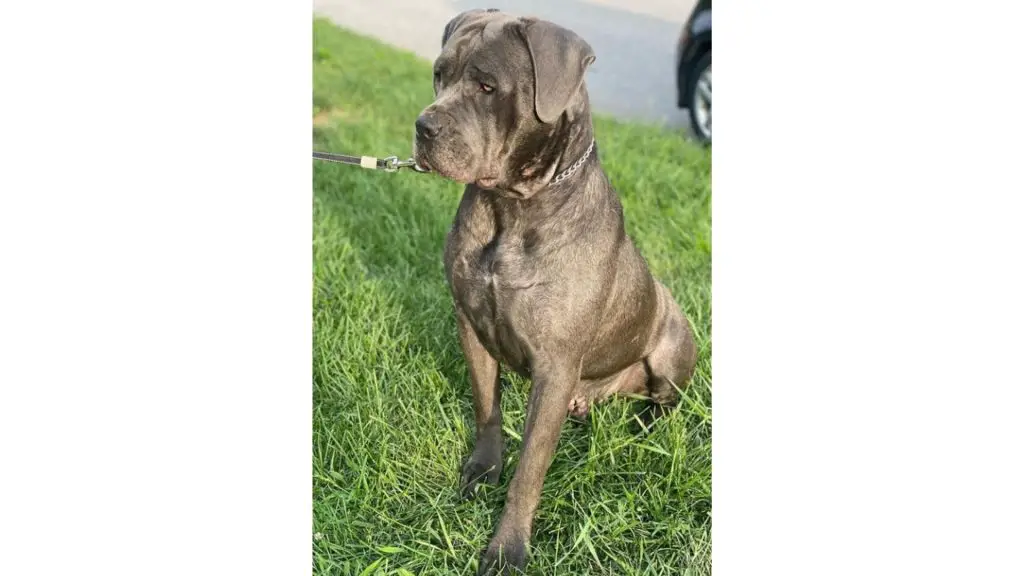Pawscessories is reader-supported. When you buy via links on our site, we may earn an affiliate commission at no cost to you.
Learn more.
The blue Cane Corso is a dog that is quickly gaining popularity in the United States.
This breed has a long and interesting history and is known for its loyal temperament and impressive physical appearance.
This blog post will cover everything you need to know about the blue Cane Corso. We will discuss its history, physical appearance, size, coat markings & texture, temperament, and many other frequently asked questions about these dogs.
Let’s jump right in.
Table of Contents

What Is a Blue Cane Corso?
A blue Cane Corso is actually more of a shade of gray. In the AKC standard for Cane Corsos, they share that darker shades of gray are recognized by the association.
Nowhere do they mention a blue Cane Corso, and nowhere can you find a legitimate blue dog. However, because the shade of gray is so light, it can appear blue in certain lighting conditions.
With that being said, the blue Cane Corso is really no different from other Cane Corsos outside of their coat. So let’s take a quick look at the Cane Corso history to better understand why these dogs look and behave how they do.
The breed has a long history, dating back to the Roman Empire.
In those days, the Cane Corso was used as a guard dog, hunting dog, and war dog.
The breed nearly went extinct after the fall of the Roman Empire, but fortunately, some dedicated breeders were able to keep the Cane Corso alive.
In the 1970s, the breed began to gain popularity in Italy and other parts of Europe.
In the 1990s, the Cane Corso finally made its way to America.
Today, the breed is still used as a working dog in some parts of the world, but it is more popular as a family pet.
Blue Cane Corso Genetics: What Makes Them Blue?
A dog’s coat color is determined by the genes it inherits from its parents.
The two main types of pigment that contribute to coat color are eumelanin, which is responsible for black and brown tones, and phaeomelanin, which gives rise to red and yellow tones.
The relative amounts of these pigments determine the final color of the coat.
For example, a dog with a high concentration of eumelanin will have a black coat. In contrast, a dog with a low or a diluted pigmentation of eumelanin will have a grayish coat.
This is what is happening in the blue Cane Corso. The dog has a gray coat because it has a low concentration of eumelanin.
However, the phaeomelanin is not affected, which means they can still have brown eyes and noses.
The blue color is simply a result of the diluted eumelanin pigmentation.
Is a Blue Cane Corso Rare?

Yes and no.
Blue Cane Corsos are considered rare, but that doesn’t mean they’re not available.
While most people think of blue as a color, it’s actually a shade that can vary greatly. In the world of Cane Corsos, the blue coat color is usually somewhere in the middle – not as common as black or brindle, but not as rare as white.
If you’re looking for a blue Cane Corso, your best bet is to check with specialty breeders.
However, be prepared to pay a premium price; because of their rarity, blue cane corsos often come with a higher price tag than other colors.
It’s also important to keep in mind that coat color should be a secondary thought for any breeder you’re working with. But, of course, there are ways to increase the likelihood that a blue Cane Corso puppy will be born.
But, it should never come before choosing two healthy Cane Corso parents to breed.
Blue Cane Corso Female Vs. Male
When it comes to choosing a blue Cane Corso, there are no major differences between male and female dogs.
Both sexes make great family pets and are equally likely to inherit the blue coat color.
However, there are some slight differences between males and females you should be aware of before making your decision.
For example, male Cane Corsos are typically larger than females.
They also tend to be more independent and take longer to mature, which can make them more challenging to train.
Females, on the other hand, are typically smaller and more easygoing.
They also mature faster, which can make them generally easier to train.
At the end of the day, it really comes down to personal preference.
Both can be lovable family pets, but these differences are definitely something to consider.
Blue Cane Corso Appearance & Traits

Size (Weight & Height)
The blue Cane Corso is a large dog.
Males typically weigh between 100 and 120 pounds, while females weigh between 90 and 110 pounds.
When it comes to height, males typically stand between 25 and 27 inches tall, while females stand between 23 and 25 inches tall.
Coat Markings & Texture
The blue Cane Corso has a short, dense coat that is easy to care for.
Their coat is typically either solid or with minimal white markings.
The texture of their coat is typically smooth, but some dogs may have a slightly coarse coat.
Shedding & Grooming
Blue Cane Corsos are moderate shedders. They’ll shed throughout the year and have two times during the year where they shed more than usual (typically in the spring and fall).
When it comes to the other areas of grooming, they require a similar amount of maintenance as other dogs.
Bathing should take place roughly every 2-3 months, nail trimming and ear cleaning should happen once a month, and teeth cleaning should be done several times per week.
Are Blue Cane Corsos Hypoallergenic?
No, the blue Cane Corso is not a hypoallergenic dog.
While they don’t shed as much as some other dogs, they do still shed, which can trigger allergies in people who are sensitive to pet dander.
Ears & Tail
The ears of a blue Cane Corso are medium in size and floppy.
They typically have a slight taper to them and hang down close to the cheeks.
Their tail is typically long and thick.
You may also see them with cropped ears and a tail. However, this is much more controversial nowadays as there’s no reason for it to be done.
In the past, people would crop a working dog’s ears and tail to prevent injury.
But now, there’s no real need for it, and many people believe it’s an inhumane practice.
Eye Color
The eyes of a blue Cane Corso are typically dark brown.
However, you may also see them with hazel, light brown, black, and even blue eyes.
Lifespan

The typical lifespan of a blue Cane Corso is between 9 and 12 years.
Of course, this can vary depending on individual factors such as diet, exercise, health conditions, etc.
But generally, you can expect a blue Cane Corso to live for a decade or more.
Common Health Issues
The blue Cane Corso is a relatively healthy dog. However, like all dogs, they are prone to developing certain health conditions.
Some of the most common health issues that affect blue Cane Corsos include hip dysplasia, eyelid abnormalities, bloat, color dilution alopecia, and demodectic mange.
Hip dysplasia is a condition where the hip joint doesn’t develop properly. This can lead to pain, lameness, and even arthritis later in life.
Eyelid abnormalities are relatively common in dogs and can cause a variety of problems, such as dry eyes, tearing, and inflammation. Certain eyelids problems these dogs are more prone to are cherry eye and entropion.
Bloat is a condition that affects the stomach and can cause it to twist. This is a serious condition that can be deadly if not treated immediately.
Color dilution alopecia is a condition that affects dogs with blue coats. It’s caused by a mutation in the coat color gene and can lead to hair loss and balding.
Demodectic mange is a skin condition caused by mites. It’s relatively common in dogs, and while it’s not usually serious, it can be considerably uncomfortable for them.
If you’re considering getting a blue Cane Corso, be sure to talk to a vet about the health risks and what you can do to help prevent them.
Trainability & Intelligence
The blue Cane Corso is a very intelligent dog. They’re quick learners and are typically easy to train. However, they can also be stubborn at times.
It’s important to start training and socialization early with these dogs because of their size.
They can become too rambunctious and difficult to handle if they’re not properly trained.
Like all dogs, they respond best to positive reinforcement such as treats and praise.
And you’ll need to be consistent, patient, and firm in your training.
Activity Level & Exercise Needs
Blue Cane Corsos are relatively active dogs. They need a fair amount of exercise to stay healthy and happy.
A good rule of thumb is to give them at least 30-45 minutes of exercise per day. This can be in the form of walks, runs, playing fetch, etc.
If you don’t give them enough exercise, they can become bored and destructive. Which can show up with them becoming overly vocal, anxious, or chewing apart items in your home.
The best way to combat this is by ensuring they get plenty of physical and mental stimulation each day.
A few ways to help keep their mind occupied are by teaching them new tricks/behaviors, playing interactive games, and giving them chew toys.
Doing these things will help wear them out both physically and mentally, which will help prevent them from becoming destructive.
Temperament & Behavior

Do Blue Cane Corsos Bark A Lot?
The blue Cane Corso is not a particularly vocal dog. They will bark when they feel it’s necessary, but they’re not known for being yappy dogs.
However, they may bark more than usual if they’re bored or anxious.
Do Blue Cane Corsos Like To Cuddle?
This can vary from dog to dog. Some blue Cane Corsos enjoy cuddling and being close to their owners, while others prefer to keep their distance.
It really depends on the individual dog’s personality. However, the best way to help them enjoy cuddling is to give them plenty of positive experiences cuddling when young.
This way, they associate closeness with a loving experience and are much more likely to want to continue doing it as they get older.
Are Blue Cane Corsos Good With Kids?
Yes, blue Cane Corsos are generally good with kids. They’re patient, gentle, and have a lot of love to give.
However, it’s important to always supervise them around children as they can unintentionally knock them over due to their size.
And like all dogs, they should never be left alone with a child unsupervised during their initial interactions. However, once they’ve shown you that they know how to play nice with one another, you can be more confident leaving them for short periods.
Are Blue Cane Corsos Good With Other Dogs?
The blue Cane Corso is generally good with other dogs. Due to their guard dog history, they can be a little reserved around new dogs they haven’t met before.
However, if they are properly socialized from a young age, they should have no problems with other dogs.
Are Blue Cane Corsos Good With Strangers?
Blue Cane Corsos can be a little aloof and suspicious around strangers.
It’s important to expose them to as many different people in different situations as possible when they’re young. This will help them become more comfortable and trusting around new people as they get older.
If you have visitors over often, make sure to introduce your dog to them gradually so that they have a chance to get used to one another.
Are Blue Cane Corsos Good Apartment Dogs?
Apartment living isn’t ideal for a blue Cane Corso. They need a fair amount of exercise to stay happy and healthy, and an apartment simply doesn’t provide enough space for them to run around and burn off energy.
If you live in an apartment, you’ll need to be extra diligent about giving them plenty of exercise each day. This may include multiple walks, runs, or trips to the dog park.
If you’re not able or willing to put in the extra effort, then an apartment is not the right environment for a blue Cane Corso.
Food & Diet
A blue Cane Corso should be fed a high-quality diet that’s rich in protein.
The best way to ensure they’re getting the nutrients they need is to feed them a commercially prepared food specifically designed for large breeds.
You can also supplement their diet with cooked meat and vegetables. Just make sure not to feed them anything that’s high in fat or sugar, as this can cause weight gain and other health problems.
The amount of food you should feed your blue Cane Corso will depend on their age, activity level, and build.
As a general rule of thumb, you should feed them two to three cups of food per day.
Puppies will need more food as they’re growing and active, while adults may need less depending on how much exercise they get.
Blue Cane Corso Puppy Price

A blue Cane Corso puppy will cost you anywhere from $1200 to $4000.
The price will depend on factors like the breeder’s reputation, the dog pedigree, whether or not they come with any health clearances, whether you want breeding rights, etc.
Puppies that come from show lines or working lines will usually be on the higher end of the price range.
If you’re looking for a pet-quality dog, you can expect to pay less.
Also, always make sure you are working with a reputable breeder.
Unfortunately, there are unethical breeders out there who are looking to make a quick buck by selling sick or unhealthy puppies.
Where Can You Find a Blue Cane Corso Puppy For Sale?

There are a few different ways you can find a blue Cane Corso for sale.
You can look at your local animal shelters or rescue groups or search online for breeders that have blue Cane Corsos for sale.
A great way to start your search online is to check out breeder directory websites. Ones like AKC’s Marketplace, Greenfield Puppies and Lancaster Puppies.
Just make sure you do your research before working with any breeder.
While these sites do their best to only list breeders with a good reputation, it’s still best practice for you to vet them yourself as well.
Another great way to find a reputable breeder is to ask for recommendations from friends or other dog owners who have purchased a puppy from a breeder in the past.
Final Thoughts
The blue Cane Corso is a beautiful and loyal dog that makes a great addition to any family.
They’re intelligent, loving, and protective but can also be stubborn and require firm yet gentle training.
Because of their large size, they’re not the best breed for first-time dog owners.
But if you’re looking for a big, loving, and protective dog, the blue Cane Corso may be a great choice for you. Just make sure you do your research and purchase from a reputable breeder.
Other posts you might find interesting:
